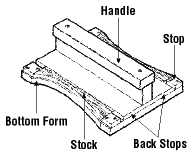Woodworking Machines - Shapers
On this page
What should you do before using shapers?
Back to topShapers can be dangerous if not used properly.
- Read the owner's manual carefully.
- Make sure you understand instructions before attempting to use any tool or machine. Only trained, experienced personnel should be allowed to operate wood shapers.
- Learn the applications and limitations before use.
- Refer to Woodworking Machines - General Safety Tips for general safeguards.
What safety procedures should you follow when using shapers?
Back to top- Wear safety glasses with side shields or safety goggles, or a face shield (with safety glasses or goggles).
- Wear hearing protection that is suitable for the level and frequency of the noise you are exposed to in the woodworking area.
- Wear protective footwear when required.
- Wear respiratory protection when required.
- Use the cutter (and spindle speed / RPM) suited for the job.
- Use sharp cutters only and keep them clean.
- Remove all wrenches and tools used in the set up from the table.
- Check moving parts of the shaper periodically such as belts and pulleys for signs of wear; also check the spindle for burrs or for excessive runout.
- Make sure all guards are in proper position.
- Before operating, check that the spindle is square with the shaper table; that the spindle top and knives are correctly adjusted and securely fastened; and that the spindle is free before turning on the power. If in the wrong position, cutters may make a "chattering:" noise or appear loose. Turn off the power, unplug the machine, and correct any issues before continuing.
- Operate at speeds recommended by the manufacturer.
- Use jig fixtures, holders, and hold-down push blocks. Fasten the work securely in a jig. When a table guide pin is used, make sure it is adjusted and will not slip.
- Cut with the grain rather than against it.
- Remove all other blades when one blade is removed from the shaper spindle. This will prevent the other blades from being hurled from the spindle if the machine is started.

- Turn off power, and lock out a machine when making any adjustments or changes in the set up..
- Shape only one piece of stock at a time.
- Use extra care in machining stock that contains cross grains or knots. These may pull the operator's hands into the knives or may cause kickbacks.
- Shape stock only if longer than 25 cm (10 in).
- Support long pieces of wood with extension tables or roller supports.
What should you avoid when using shapers?
Back to top- Do not leave a shaper machine running. Make sure that the power is shut off and that the cutter head has stopped revolving before leaving the area.
- Do not rest your hands near the edge of the stock being cut.
- Do not tamper with the guards or make them inoperative in any way.
- Do not back up the stock (check to see that the direction of rotation is as expected). Always feed against rotation of the cutter.
- Do not make deep cuts or feed the stock too rapidly.
- Do not cut stock that has loose knots, splits, defects or foreign objects (e.g., metal, stone) in it.
- Do not distract or startle an operator during a shaping operation.
- Do not remove saw dust or cuttings around knives by hand or with compressed air. Use a stick or brush.
- Do not clear the table while the cutter is rotating.
- Do not accumulate stock or finished work on the table.
- Do not stand in line with the stock being fed.
- Do not wear loose clothing, work gloves, neckties, rings, bracelets or other jewellery that can become entangled with moving parts.
- Fact sheet last revised: 2019-08-09
